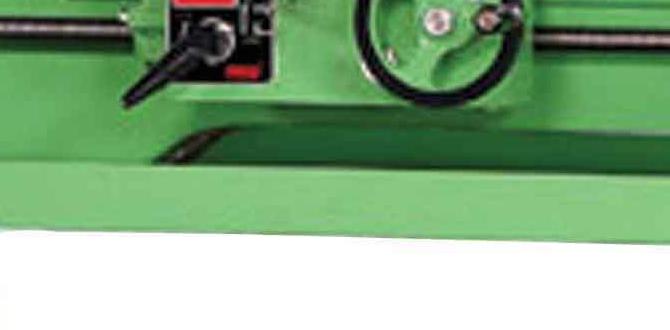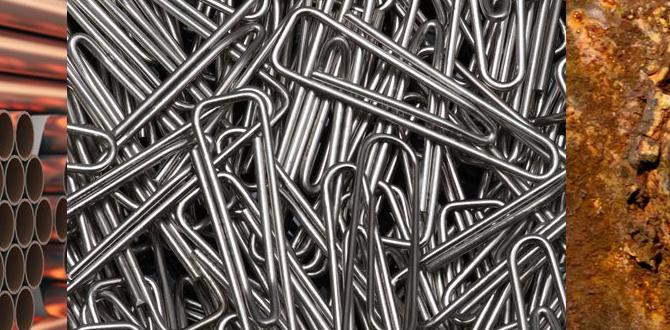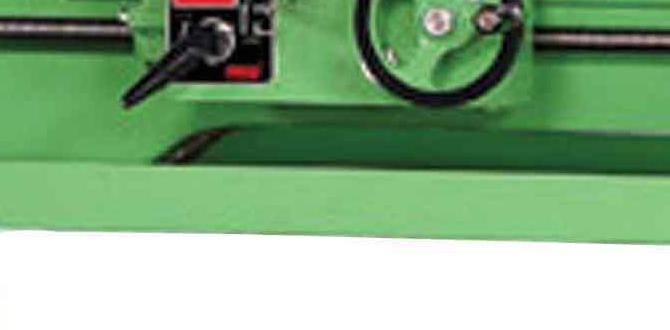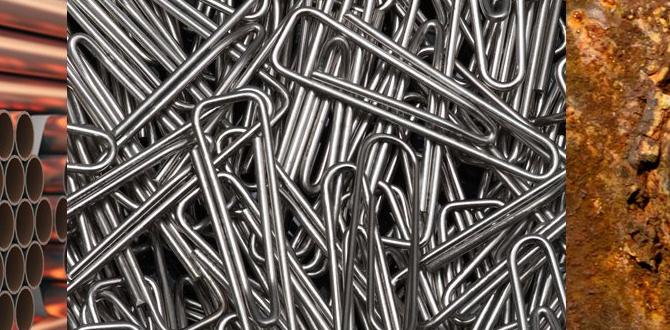Single Flute vs 2 Flute End Mill for Copper: The Stunning Choice for Your Project!
Choosing the right end mill for copper can seem tricky. But don’t worry! For most copper cutting, a single flute end mill usually gives you the best results. It’s designed to clear chips easily and prevent clogging, giving you cleaner cuts and a smoother finish on your project.
When you’re working with materials like copper on your lathe or milling machine, picking the right cutting tool is super important. It’s like choosing the right brush for a painting – the wrong one can make your masterpiece look messy! Many hobbyists and beginners find themselves scratching their heads when faced with a tool cabinet full of end mills. You see them: some with one cutting edge, some with two, and wonder which one is the best for that shiny piece of copper you’ve got. It’s a common question, and getting it wrong can lead to clogged tools, rough finishes, or even broken bits. But don’t let that discourage you! Today, we’re going to make this choice crystal clear. We’ll break down exactly why a single flute end mill often shines when cutting copper, and when you might consider its two-flute cousin. Get ready to choose the right tool with confidence!
Why Copper Needs a Special Touch
Copper is a bit different from other metals. It’s soft, yes, but it’s also quite ductile. This means it can be easily deformed without breaking. When you cut copper with a tool, its softness can cause it to “gum up” or stick to the cutting edges. This is called chip welding. If the chips can’t escape the cutting area, they get smeared and stick to the tool. This is a big problem because it can:
Make the cut rough and uneven.
Increase the heat generated, which can damage the workpiece and the tool.
Cause the tool to clog, eventually leading to tool breakage.
Result in a poor surface finish on your part.
This is where the design of single flute end mills really makes a difference.
Understanding End Mill Flutes
Before we pick a winner for copper, let’s quickly understand what flutes are. Flutes are the spiral grooves that run along the cutting end of an end mill. They have a few key jobs:
Cutting edges: The sharp edges of the helix are what actually machine the material.
Chip evacuation: The spaces between the flutes (called gullets) allow the removed material, or chips, to be carried away from the cutting area. This is super important for preventing clogging.
Cooling: The flutes also help to direct coolant or air towards the cutting edge to keep things cool.
The number of flutes on an end mill tells you how many cutting edges and chip evacuation paths it has.
Single Flute End Mills: The Copper Champion
A single flute end mill has just one cutting edge and one chip evacuation path. This might sound basic, but it’s precisely why it’s often the best choice for softer, gummy materials like copper.
How Single Flute Mills Conquer Copper:
Superior Chip Clearance: With only one flute, the gullet (the space between the flute and the tool’s core) is much larger. This extra space is critical for copper. As the soft copper is cut, it tends to create longer, stringy chips. The large gullet of a single flute mill can easily accommodate and evacuate these chips. Think of it like a wider highway – more chips can get out of the way quickly!
Reduced Heat Buildup: By clearing chips efficiently, you reduce friction. Less friction means less heat. For soft metals like copper, excessive heat can lead to the chips welding themselves to the tool, causing all sorts of problems.
Less Drag: With only one cutting edge engaging the material at a time, there’s less resistance. This means your machine doesn’t have to work as hard, and you’re less likely to experience chatter (unwanted vibrations) or tool deflection.
Smoother Finishes: Because chips are cleared so effectively and heat is minimized, single flute end mills often produce a much cleaner, brighter finish on copper. This means less post-machining work for you!
When to Reach for a Single Flute:
Cutting pure copper or brass.
Machining aluminum or plastics, which can also be gummy.
Achieving a very fine surface finish.
When chip evacuation is a primary concern.
Example: Machining a Copper Plate
Imagine you need to mill a slot in a 1/4 inch thick copper plate. If you use a tool with too many flutes or poor chip clearance, you might find that the copper shavings just get pushed around and stick to the tool. This can make the edges of your slot rough, uneven, and might even cause your tool to clog up and break. A single flute end mill, with its big, open space for chips, will push those copper shavings cleanly out of the slot, leaving behind a smooth, precise channel.
2-Flute End Mills: A Different Role
A 2-flute end mill has two cutting edges and two chip evacuation paths. While not typically the first choice for pure copper, they have their own advantages and uses.
Strengths of 2-Flute Mills:
Better for General Machining: Two flutes provide a more balanced cut and can often handle a wider range of materials, including steels and harder alloys, better than single flute mills.
Good for Slotting and Profiling: They can be a bit more rigid than single flute mills, making them suitable for plunging into material or performing more aggressive milling operations in materials that don’t tend to gum up.
Can Handle Higher Feed Rates (in some materials): In materials that chip well, two flutes can sometimes allow for faster material removal rates.
Why 2-Flute Might Not Be Ideal for Copper:
Machining aluminum or plastics, which can also be gummy.
Achieving a very fine surface finish.
When chip evacuation is a primary concern.
Chip Packing: The two smaller gullets in a 2-flute end mill can become packed with soft copper chips more easily. This leads to the problems we discussed: poor finish, tool wear, and potential breakage.
Increased Heat: More cutting edges engaging the material at once can generate more heat if chip evacuation isn’t perfect.
When You Might Consider a 2-Flute for Copper (with caution):
Very Light Finishing Passes: If you’re doing a very light finishing pass after roughing with a different tool, and your machine has excellent coolant or air blast, a 2-flute might work for a final skim.
Certain Alloys: Some copper alloys might behave slightly differently. However, for common electrical or plumbing copper, stay with single flute.
Specific Machining Centers: High-end CNC machines with very efficient coolant systems and specialized programs might manage a 2-flute tool on copper, but for manual operations and beginner setups, it’s riskier.
Key Differences Summarized
Let’s put the main differences side-by-side. This table should help you visualize the choice.
| Feature | Single Flute End Mill | 2-Flute End Mill |
|---|---|---|
| Number of Cutting Edges | 1 | 2 |
| Chip Clearance | Excellent (larger gullet) | Good (smaller gullets) |
| Ideal for Gummy Materials (like Copper) | High | Moderate (use with caution) |
| Heat Generation | Lower (due to better chip clearance) | Potentially Higher (if chip evacuation is poor) |
| Surface Finish on Copper | Generally Superior | Can be rough if chips pack |
| Balance | Less balanced | More balanced |
| Material Range | Best for soft metals, plastics | General purpose, some steels, alloys |
Choosing the Right End Mill for Copper: Step-by-Step
So, how do you make the actual choice when you’re standing in front of your tool rack or ordering online?
Step 1: Identify Your Material
Are you cutting pure copper (like electrical wire or plumbing pipe material)? Or is it a copper alloy like brass or bronze? Pure copper is softer and gummier.
Brass is harder than copper but still has gummy tendencies. Single flute is often still preferred.
Bronze can vary, but many bronzes benefit from single flute as well.
If you’re cutting something much harder like tool steel, you’d look at tools with 4+ flutes, but that’s a different topic!
Step 2: Consider Your Machine and Setup
Manual Lathe/Mill: For hand-controlled machines, you have more direct feel. Single flute is generally safer and easier to manage, providing better feedback.
CNC Machine: While CNCs can be programmed to manage tool paths and coolant, copper’s gummy nature still pushes towards single flute for best results, especially for smaller shops or hobbyists.
Coolant/Lubrication: Do you have a robust flood coolant system, a mist system, or are you using a manual lubricant? Excellent cooling and lubrication help, but don’t completely replace the need for good chip clearance.
Step 3: Analyze Your Machining Operation
Slotting/Profiling: Creating channels or cutting out shapes. This is where chip evacuation is paramount. Single flute is king here.
Facing: Machining a flat surface. This can sometimes work with 2-flute if the depth of cut is very shallow and feed rates are controlled, but again, single flute often provides a superior finish.
Drilling/Plunging: Pushing the tool straight down into the material. Single flute mills designed for this (like ball end mills) will have excellent chip ejection.
Step 4: Look at the End Mill Specification
When buying, look for:
Single Flute: Clearly labeled “single flute” or “1 flute”.
Material: Often made from High-Speed Steel (HSS) or Tungsten Carbide. Carbide is harder and lasts longer but can be more brittle. For hand machining, HSS is often forgiving.
Coating: For copper, coatings like “ZrN” (Zirconium Nitride) can help reduce friction and prevent chip welding. A polished or bright finish shank on the end mill also aids in chip flow.
Helix Angle: A steeper helix angle can help with chip evacuation.
Pro Tips for Machining Copper
Even with the right tool, a few extra tricks will make your copper machining incredibly successful.
Use a Lubricant/Cutting Fluid: This is crucial for copper. A good cutting fluid reduces friction, cools the cutting edge, and helps prevent chips from sticking. Products specifically for aluminum or brass often work well for copper. You can even use a light machine oil or a specialized cutting paste. For a quick DIY option, some makers have success with kerosene or WD-40, though dedicated fluids are usually better.
Control Your Speeds and Feeds:
Speed (RPM): Copper generally prefers lower speeds than harder metals like steel. Too fast, and you risk melting the copper onto the tool. Too slow, and you might not get efficient chip formation. Typical speeds for HSS in copper can range from 100-300 Surface Feet per Minute (SFM), which you’ll need to convert to RPM based on your tool diameter. For example, a 1/4 inch (0.25 inch) end mill at 200 SFM would be roughly (200 SFM 12 inches/foot) / (π 0.25 inch) = ~3056 RPM. Start conservatively.
Feed Rate: This is how fast the tool moves through the material. For copper with a single flute, you want a feed rate that allows the large gullet to scoop up and clear the chip effectively without overwhelming it. A common rule of thumb for feed per tooth (FPT) in soft metals is around 0.001 to 0.003 inches per tooth. So, for a single flute tool, this would be your feed rate in inches per revolution.
Shallow Depth of Cut (DOC): Don’t try to hog out large amounts of copper at once. Take lighter passes. This reduces the load on the tool and improves chip control. A DOC of 0.050 inches or less is often a good starting point.
Back-Cutting (Climb Milling): If your machine setup allows for climb milling (tool rotation direction matches feed direction), this can often result in a smoother surface finish and less chip welding. However, be cautious with climb milling on machines with backlash as it can over-engage the tool. Traditional “conventional milling” is often safer for beginners.
Listen and Watch: Get a feel for what the cut sounds like. A smooth, consistent whirring is good. Chattering, screeching, or sudden loud noises can indicate a problem – slow down, check your cuts, or apply more lubricant. Watch the chips – are they flowing freely? Or are they building up?
External Authoritative Resources
For more in-depth information on machining best practices, you can consult resources like:
The National Institute of Standards and Technology (NIST) provides foundational research and data on manufacturing processes.
Many university engineering and manufacturing departments offer online resources and guides for machining. For instance, looking up “machining handbook” from a reputable educational institution can yield valuable, research-backed information.
Tool manufacturers themselves often publish excellent material-specific machining data. For example, companies like Kennametal, Sandvik Coromant, or even smaller specialized cutting tool suppliers will often have guides for cutting specific alloys.
Frequently Asked Questions (FAQ)
Q1: Can I use a 2-flute end mill on copper if I’m very careful?
Yes, you can*, but it’s generally not recommended for beginners or for achieving the best results. A 2-flute end mill is more prone to chip packing in copper, leading to rough finishes and potential tool breakage. A single flute end mill is a much safer and more effective choice for copper.
Q2: What RPM should I use for a 1/4 inch single flute end mill in copper?
A good starting point for a 1/4 inch single flute HSS end mill in copper is around 750-1500 RPM. Start at the lower end and increase if you get a good chip and finish. For carbide tools, you can often go much faster, but always check the manufacturer’s recommendations and listen to your machine.
Q3: What is the best coolant or lubricant for machining copper?
Dedicated cutting fluids designed for machining softer metals like aluminum and copper are ideal. These fluids offer excellent lubrication and cooling. If you can’t get a specific fluid, a light machine oil or even a mixture of water and soluble oil (check the manufacturer’s ratio) can work. Some hobbyists have success with kerosene or WD-40, but they are not ideal for prolonged or heavy machining.
Q4: How deep should I cut into copper with a single flute end mill?
For best results and to prevent chip packing, take shallow cuts. A depth of cut (DOC) of 0.010 to 0.050 inches is a good range to start with for a 1/4 inch end mill, depending on your machine’s rigidity and the material thickness. It’s better to take multiple light passes than one deep one.
Q5: Will a single flute end mill leave a mirror finish on copper?
A single flute end mill is excellent at producing a very smooth and bright finish on copper, often much better than a 2-flute. However, achieving a true mirror finish typically requires very fine feed rates, specialized polishing tooling, or post-machining polishing steps like sanding or buffing, even on copper.
Q6: What happens if I use a 4-flute end mill on copper?
Using a 4-flute end mill on copper is generally a bad idea. The chip clearance is severely restricted with four flutes, meaning chips will almost certainly pack into the small gullets. This leads to rapid tool wear, overheating, chatter, poor surface finish, and a high likelihood of breaking the end mill. Stick to single flute for copper.
Conclusion: You’ve Got This!
Choosing between a single flute and a 2-flute end mill for copper doesn’t have to be a mystery. For the vast majority of your copper machining projects, especially if you’re a beginner working on a manual lathe or mill, the single flute end mill is your stunning choice**. Its superior chip clearance, reduced heat buildup, and ability to produce cleaner cuts make it the clear winner.
Remember to use a good cutting fluid, control your speeds and feeds conservatively, and take shallow depths of cut. By following these simple guidelines and choosing the right tool, you’ll find yourself achieving beautiful, precise results on your copper workpieces. Don’t be afraid to experiment a little at the lower end of recommended parameters, and always listen to your machine. Happy machining!







